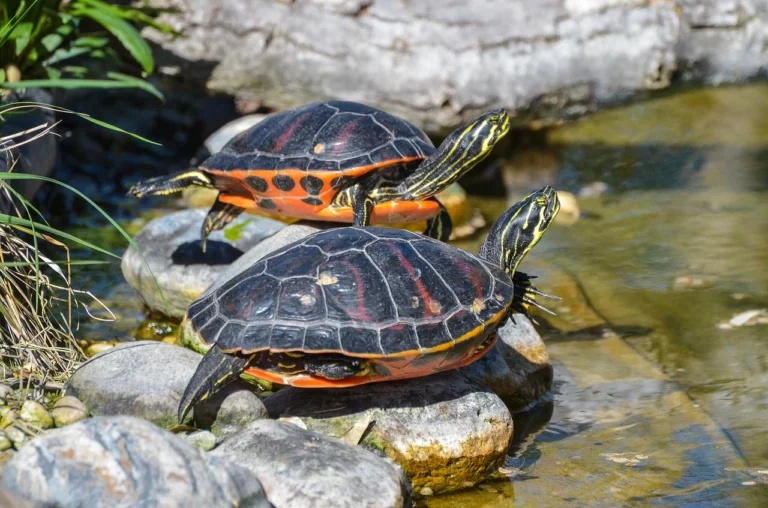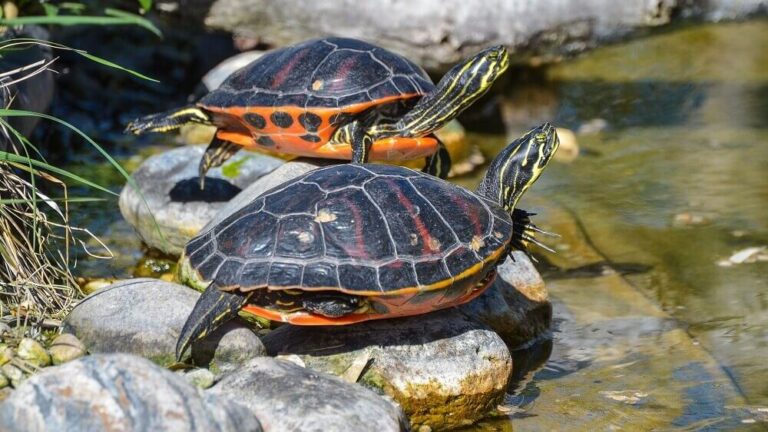Turtles are fascinating animals due to their unique physiology, diverse behaviors, and the grand variety of different types within the turtle species. Indeed, there is an array of turtle types, each living in different habitats, having divergent eating habits, and possessing variable physical characteristics.
Interestingly, turtles also share many similarities with other animals in nature, such as frogs, which are classified as amphibians. Therefore, it is only natural for someone to bare the question, is a turtle an amphibian?
Amphibians are frogs, toads, newts, and salamanders and have a complex life with cycles on land and water. Reptiles are turtles, snakes, lizards, and alligators. Let’s take a closer look at reptiles and amphibians below to further identify the distinction between the two.

What Is an Amphibian?
Amphibians are a classification of tetrapod animals that live in diverse habitats, including land, sea, and freshwater habitats, among others. Etymologically, “amphibian” means life in two states of condition.
It does not necessarily relate to life in multiple environments rather than the duality of the state of being of some species during their life cycle. While this concept might sound quite complicated, it is easily explained if we examine the most famous amphibian, the frog.
Frogs and their related kinds—toads and salamanders—live in two different states. Adult frogs lay eggs underwater, and when they hatch, tadpoles emerge and live underwater for a part of their lives.
Tadpoles can breathe underwater since they have developed gills. Of course, they eventually grow to their mature state, in which they develop lungs and breathe air. After reaching maturity, many types of frogs live a certain part of their lives on land.
What Is a Reptile?
Reptiles are another classification of animals, mainly referring to a grouping that includes snakes, crocodiles, and lizards. Much like amphibians, reptiles also live in various habitats, including the desert, the ocean, and freshwater. Within the reptile category, a large variety of species differ quite a lot from the rest of the animals that are considered reptiles.
In contrast to amphibians, reptiles do not go through the phase of living and breathing underwater, even though many spend a lot of time in the water. Even aquatic reptiles cannot breathe underwater as they have lungs and must return to the surface to breathe. Moreover, reptiles generally lay eggs, but almost always, they do so on dry land.

What Are the Main Differences Between the Two?
At first sight, reptiles and amphibians seem to have many similarities in appearance and behavior. However, they differ quite a lot in reality.
The main difference is that reptiles do not go through the process of metamorphosis that amphibians do. As mentioned earlier, amphibians are born and can breathe underwater through gills during their larval life as tadpoles.
Metamorphosis is what eventually transforms tadpoles into frogs. This metamorphosis can transform aquatic organisms into semi-aquatic or terrestrial ones. Even in the case of aquatic reptiles, they cannot breathe underwater at any point in their lives as all reptiles are born with lungs. Therefore, if they are born aquatic or terrestrial, they will remain so for the entirety of their lives.
Another difference is that amphibians reproduce externally while reptilians mate. External reproduction means that female amphibians lay their eggs externally, and the male ones fertilize them. An amphibian egg, which is generally fertilized and left underwater, has a gelatinous cover. After mating, reptiles lay their eggs on dry land. Their eggs have hard shells that need to be hatched.
Finally, reptiles are typically known for having hardened, dry skin covered by scales. In contrast to this scaly skin, amphibians have smoother and more slippery skin, and some kinds of amphibians use their skin as a secondary respiratory organ that helps them breathe underwater.
What Are Their Similarities?
Their main similarity is that amphibians and reptile species are ectothermic, meaning they are cold-blooded. This means that neither of them can regulate their own body temperature. Therefore, they rely on the temperature of their environment to get warm. This leads to the creation of the much-needed habit of basking, which is common to both amphibians and reptiles.
Another similarity is that both amphibians and reptiles can live in various habitats. There are aquatic, semi-aquatic, and terrestrial adult amphibians; the same is true for reptiles. Both kinds also have three-chambered hearts, which can better help with the direction of oxygenated and deoxygenated blood vessels within the body.

In Which Category Does the Turtle Fall?
After examining turtles closely, one can conclude that they are quite different from most amphibians. For example, by comparing turtles to frogs, we can see that they have different life cycles. Their larval lives are nothing alike due to the extreme impact that metamorphosis has on frogs.
Turtles do not experience anything remotely similar to amphibian metamorphosis, which ultimately makes them very dissimilar. Moreover, their breeding practices are not alike at all.
Physiologically, they are also very dissimilar. Amphibians use their skin as an extra respiratory system on top of their lungs, which turtles do not have. Amphibians also have smooth and moist skin and lack tails during their mature stages.
Turtles have much more in common with the reptile species. They are born on land as they hatch out of eggs with hard shells like most reptiles. This is also true for the sea turtles, which specifically go on land to lay their eggs and only when the babies are born, do they return to the ocean. Turtles also have scaly skin and often longer tails.
Moreover, while they cannot breathe underwater, some turtles can hold their breath for quite some time. Finally, while amphibians are generally seen in freshwater habitats and cannot live in the ocean, many aquatic and semi-aquatic reptiles love saltwater.
What Characteristics of Turtles Make Them Reptiles?
In summary, a reptile is an amniote. It is an animal that has a hard shell on the outside of its body. Reptiles can also live on land or in water. Amphibians, on the other hand, lay eggs in the water and their skin is moist and without scales.
The painted turtle otherwise known as Chrysemys picta, is a turtle from North America and is a good representation of a reptile. The painted turtle has a smooth shell. They are also an aquatic turtle species commonly found in slow moving bodies of water.
For all the reasons mentioned above, it becomes evident why turtles are officially categorized as reptiles and not amphibians since they lack many of the main characteristics that define the latter.






